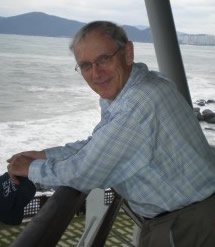Syracuse Alumnus Receives National Physics Prize
Pierre Ramond G’69 awarded Dannie Heineman Prize for Mathematical Physics

An alumnus of Syracuse University’s College of Arts and Sciences has received one of physics’ most prestigious research prizes.
Pierre Ramond G’69, who earned a Ph.D. in physics from Syracuse, is the winner of the 2015 Dannie Heineman Prize for Mathematical Physics. He was recently notified of the award by the American Physical Society (APS) and American Institute of Physics (AIP), on behalf of the Heineman Foundation for Research, Educational, Charitable, and Scientific Purposes.
Ramond is on faculty of the University of Florida (UF), where he serves as Distinguished Professor of Physics and director of the Institute for Fundamental Theory. He is being recognized for his cutting-edge work in supersymmetry and superstring theory.
"Since the days of ancient Democritus, philosophers and scientists who pondered what makes up the fundamental building blocks of matter have thought about point-like particles—first, atoms; then subatomic particles, like electrons or quarks," says H. Frederick Dylla, executive director and CEO of AIP. "By initiating superstring theory in the early 1970s, Pierre Ramond generalized … that the basic building blocks are not point particles at all, but [are] tiny string-like objects that vibrate to form the particles."
Physicists generally agree that, during the Big Bang (13.8 billion years ago), these strings vibrated like a quantum violin and, in the process, generated all elementary constituents of the Universe. Some of these elements have been discovered; others have not.
It was while serving a postdoctoral fellowship at what is now the Fermi National Accelerator Laboratory (Fermilab), outside of Chicago, that Ramond took this idea a bit further. In his landmark article, “Dual Theory for Free Fermions” (American Physical Society, 1971), he proposed a hypothetical construct called supersymmetry. This two-dimensional approach to string theory suggests that all subatomic particles are either matter particles (i.e., fermions) or force-carrying particles (i.e., bosons) that join together to form the visible Universe.
“If this picture is correct, the Universe was quite simple at the time of the Big Bang, since all the constituents of the Universe had a common origin,” writes Ramond, during a recent email exchange. “Since then, the Universe has evolved into the wonderful diversity that we observe in the natural world today.”
Originally, string theory was confined to bosons—what Ramond refers to as “particles that create forces that bind stuff together.” By adding fermions to the mix, string theory has acquired a rich mathematical structure known as supersymmetry.
“It turns out that supersymmetric models require new kinships between elementary particles,” he adds. “They display unexpected and profound connections with different physical systems and pure mathematics.”
Pretty heady stuff for someone who originally wanted to be an engineer. Born and raised outside of Paris, Ramond moved to the United States after high school and earned an electrical engineering degree from the New Jersey Institute of Technology (NJIT).
In those days, most NJIT alumni didn’t pursue graduate school, but Ramond was the exception. He applied to Syracuse, which gave him a four-year fellowship.
“One formative vignette involved Physics Professor Josh Goldberg [G’50, G’52], who asked me what a vector was,” recalls Ramond, alluding to the study of motion, where a quantity has both magnitude and direction. “Also, Professor A.P. Balachandran taught me the joys of doing physics, while adhering to precise mathematical structures.”
After his groundbreaking work at Fermilab, Ramond held a variety of faculty positions at Yale University and the California Institute of Technology (Caltech), before settling down at UF in 1980. Since then, he has authored numerous books and articles on high-energy theory.
Although Ramond hasn’t been back to Syracuse for years, his legacy lives on through colleagues and former students. One of them is Mark Bowick, the J. Dorman Steele Professor of Physics, whom Ramond mentored at Caltech.
“Pierre Ramond has not only been a wonderful scientific mentor and Ph.D. advisor, but also a lifelong friend,” says Bowick, who also directs Syracuse’s Soft Matter Program. “When I graduated, he took me aside and asked ‘Now what problems do you really want to work on?’ This has inspired me to follow my own path in science.”
Ramond returns the compliment: “With someone of Mark's quality, advisers don’t matter very much. I was lucky he chose me to lead him through graduate school.”
The Heineman Prize consists of a certificate and a $10,000 award, which will be presented to Ramond at a special ceremony during the April 2015 APS meeting in Baltimore, Md.
Housed in the College of Arts and Sciences, the Department of Physics has been educating students and carrying out research for more than 125 years. Graduate and undergraduate opportunities are available in fields ranging from biological and condensed matter physics, to cosmology and particle physics, to gravitational wave detection and astrophysics.
Media Contact
Rob Enslin
